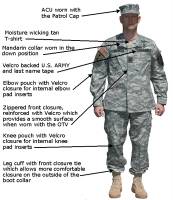New US Army uniform

The new colour scheme chosen by the US Army seems to indicate the realisation that most future conflicts would be fought in an urban environment, hence the mainly grey scheme.

The new colour scheme chosen by the US Army seems to indicate the realisation that most future conflicts would be fought in an urban environment, hence the mainly grey scheme.
The ACU consists of a jacket, trousers, patrol cap, moisture wicking t-shirt and the recently adopted Army Combat Boot (Temperate and Hot Weather). The new ACU is the culmination of many months of research and development by Soldiers, for Soldiers, and is the uniform of choice by the overwhelming majority of Army leaders and Soldiers.
The ACU enhances Soldier performance by providing a uniform that is tailorable to the individual mission; provides enhanced functionality and ergonomics over the existing BDU; and does away with requirements to procure uniforms focused on specific environments making the ACU deployable worldwide. The ACU will be fielded to deploying units beginning February 2005 and will complete Army wide fielding NLT December 2007.
The $88 cost of the new uniform jacket and pants (a $34 increase over the current BDU) will be offset by:
-Proposed increase, as yet to be determined, in the monthly Clothing Replacement Allowance for enlisted Soldiers
-A permanent press treatment that eliminates the need for Soldiers to pay for costly dry cleaning of their uniforms.
-No added cost to Soldiers for additional sewing due to the use of hook and pile or pin-on patches, nameplates, and badges
-Army-wide savings realized by streamlining procurement and stockpiling of one uniform for all environments instead of maintaining the BDU in the woodland and desert patterned sets
-Decreased manufacturing costs as processes are refined.
The Army Black Beret will remain authorized for wear with the new ACU; no decision has been made concerning whether the ACU will replace any uniform other than the BDU/DCU. The ACU, including component materials, will be manufactured in the United States using the same industrial base that produces the current uniform, thereby, ensuring the highest quality control and assisting the American work force.
No comments:
Post a Comment